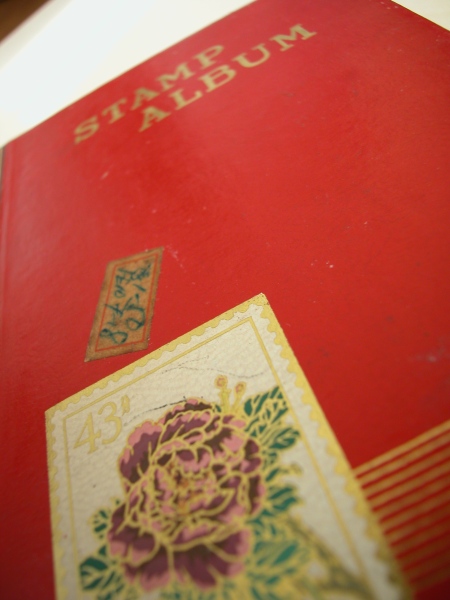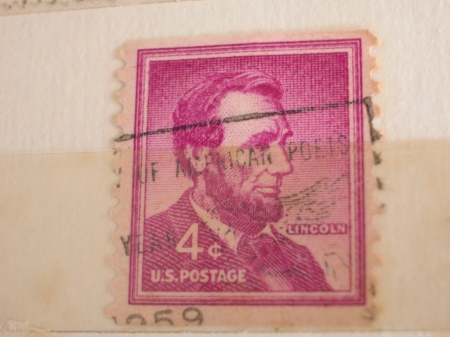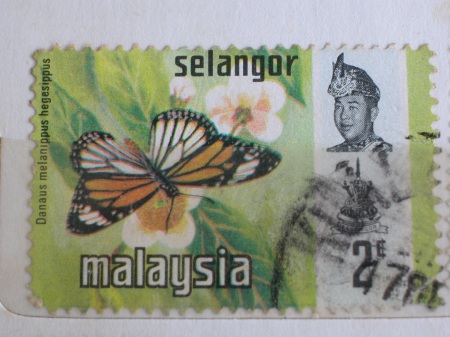Typing a few sentences on the keyboard, a click, and your message is sent to your recipient in nano seconds. In the past, it was snail mail that sometimes took some weeks to reach your intended recipient residing in some faraway country…with a postage stamp pasted on the top right hand corner of the envelope.

^ A small red postage stamp album bought in 1972. Costing $1.50, the album is about half the size of an A4 paper and has pages with sleeves to hold postage stamps. Serious collectors will usually have albums of a larger size to segregate their collections of postage stamps according to countries, events etc.

^ Some of the common postage stamps collected during the early 70s during primary schooldays. These were stamps bearing images of Singapore’s culture such as the Indian dance, Chinese wayang, lion dance, flowers like the orchid collection, and the crayon drawings by children.

^ S.A.T.A, the acronym for Singapore Anti-Tuberculosis Association. TB (short form for tuberculosis) is an infectious disease caused by mycobacteria that can be transmitted between humans via sneezing, coughing, sputum. One protective measure is vaccination. Many may remember the BCG (Bacillus Calmette-Guerin) vaccination scar we received during infancy and another booster jab during primary 6. Ouch!!

^ A stamp commemorating the 10th Anniversary of NOL with a drawing of MV Neptune Spinel. She’s a 14,967 DWT General Cargo Tramp built in 1978.

^ During the days of our parents, units of measurement for weight, volume, distance comes in the form of lbs, ounces, cubic feet, gallons, inches, miles. All was changed to using metric when we started school at primary level.
The metric system was first proposed by Gabriel Mouton in 1670. He was the Vicar of St Paul’s Church in Lyons as well as an astronomer. He was given recognition by the authorities to be the originator of the metric system.

^ A postage stamp of six-and-a-half pence bearing the image of Queen Elizabeth. Some of these postage stamps from foreign countries were traded among classmates / neighbourhood kids for added variety to our collection.

^ An image of Pope Paul VI commemorating his pilgrimage to Jerusalem in 1964. He was Archbishop of Milan and later became the head of the Roman Catholic Church (1963-1978). During his papacy, he encouraged and fostered ecumenical relations and was known as the “pilgrim pope” for his many pilgrimages to the various countries that spanned across the 7 continents. He also saw to the close of the Second Vatican Council (Vatican II) which was held from 1962-1965 in Rome.

^ A United States postage stamp bearing the face of Abraham Lincoln. He was the 16th President of the United States. During his presidency from March 1861 to his assassination in April 1865, he successfully led his country through the American Civil War and ending slavery.

^ Christmas 1974. This stamp was probably traded with someone else given that I do not have any friends nor relatives residing in Australia at that time.

^ Stamps from across the Causeway are also easily obtained. Corresponding with relatives and friends through letters especially during festivities like the Chinese New Year provided an opportunity to expand the collection.

^ This postage stamp bears the scene of Queen Elizabeth Walk during 1905-1910. Much of the landscape of Queen Elizabeth walk has changed after a century to its present. So were the use of stamps for pasting onto the envelope which holds the reflection of ourselves in the style and neatness expressed in our handwriting seen on the letters and postcards we send via postal mail…time to find that bottled ink known as Quink and the Hero fountain pen kept somewhere in the drawers.
February 18, 2011 at 11:30 am |
I stumbled upon your blog while searching for middle road church. very nice pictures and you provide very good write up of singapore history. Thank you for sharing!